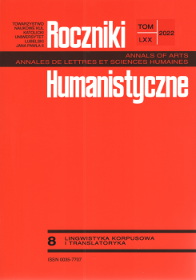French Direct Defining Statements and Their Lithuanian and Polish Equivalents in the Parallel Corpus
Abstract
This article deals with defining statements containing the markers désigner, signifier, vouloir dire and c’est-à-dire. The linguistic data come from the parallel corpus of contemporary French-Lithuanian-Polish literary texts. The analysis focuses on the Lithuanian and Polish equivalents of the selected markers. We seek to know (1) what are these equivalents in the two languages of translation, and (2) if there are regularities in the translations of the statements with the selected markers. In the case of désigner, the Polish and Lithuanian translations retain the character of the defining statement, in which the sign→thing relationship is expressed. The interpretative relationship of defining meaning statements (the markers signifier and vouloir dire) is also mostly preserved in translation. However, the character of paraphrastic reformulation, present thanks to c’est-à-dire, is kept in Polish only in 3 cases of 19 with czyli. In Lithuanian, this relationship persists in 11 cases, thanks to two markers: tai yra and kitaip tariant.
References
Altenberg, Bengt, & Sylviane Granger. Lexis in Contrast. Corpus-based approaches. Benjamins, 2002.
Auger, Alain. Repérage des énoncés d’intérêt définitoire dans les bases de données textuelles, thèse de doctorat, Université de Neuchâtel, 1997.
Johansson, Stig. « Seeing through multilingual corpora. » Corpus Linguistics 25 Years On, éd. Roberta Facchinetti, Rodopi, 2007, pp. 51-71.
Gosselin, Laurent. Temporalité et modalité en français. Duculot, 2005.
Guidère, Mathieu. Introduction à la traductologie : penser la traduction : hier, aujourd’hui, demain. De Boeck–Duculot, 2011.
Mortureux, Marie-Françoise. « Paraphrase et métalangue dans le dialogue de vulgarisation ». Langue française, 53, 1982, pp. 48-81.
Murât, Michel, & Bernard Cartier-Bresson. « C'est-à-dire ou la reprise interprétative ». Langue française, 73, 1987, pp. 5-15.
Nádorníková, Olga. « Pièges méthodologiques des corpus parallèles et comment les éviter ». Corela». HS-21, 2017, journals.openedition.org/corela/4810. DOI : 10.4000/corela. 4810. Consulté 30.04.2021.
Rebeyrolle, Josette. Forme et fonction de la définition en discours. Université Toulouse II, Thèse de Doctorat Nouveau Régime, 2000.
Rebeyrolle, Josette, & Ludovic Tanguy. « Repérage automatique de structures linguistiques en corpus : le cas des énoncés définitoires ». Cahiers de Grammaire, 25, 2000, pp. 153-174.
Rey-Debove, Josette. Étude linguistique et sémiotique des dictionnaires français contemporains. Mouton, 1971.
Riegel, Martin. « Définition directe et indirecte dans le langage ordinaire : les énoncés définitoires copulatifs ». Langue française, 73, 1987, pp. 29-53.
Riegel, Martin. « La définition, acte du langage ordinaire – De la forme aux interprétations ». La définition, éd. Jacques Chaurand & Francine Mazière, Larousse, 1990, pp. 97-110.
Rossari, Corinne. Les opérations de reformulation. Analyse du processus et des marques dans une perspective contrastive français-italien. Peter Lang, 1994.
Wimmer, Christine. « L’explication de la relation signe-signifié dans le discours non lexicographique ». Langue française, 73, 1987, pp. 54-75.
Copyright (c) 2022 Roczniki Humanistyczne

This work is licensed under a Creative Commons Attribution-NonCommercial-NoDerivatives 4.0 International License.





